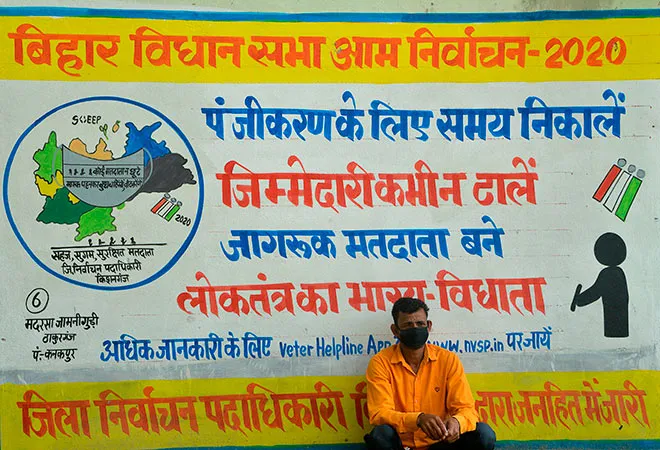
Elections in India unfolds significant and unprecedented lessons for getting a grasp of the incessantly changing dynamics of democratic politics. Given the multilayered and overlapping nature of social bases, the impactful emotive appeals of identity and development and the all-pervasive influence of personalities, every election in India provides crucial political messages. The recently-concluded Assembly elections in the state of Bihar, which happens to be the first major election amidst the pandemic in India, is certainly one of them.
The Bihar elections have been extremely significant for understanding the larger dynamics of Indian politics in the coming times. This is mainly because this election provides an opportunity to understand and analyse how the Indian people have assessed the government’s handling of the health and economic crisis which has stemmed from the ongoing pandemic.
Results at a glance
This election was majorly a fight between two political coalitions. One is the ruling National Democratic Alliance (NDA) comprising the Bharatiya Janata Party (BJP) and the Janata Dal (United) led by Chief Minister Nitish Kumar in the State. Smaller parties like the Hindustani Awam Morcha (HAM) and Vikassheel Insan Party (VIP) also fought on NDA’s side in these elections. The other alliance called the Mahagathbandhan is made up of opposing parties comprising the Rashtriya Janata Dal (RJD), the Indian National Congress (INC) and the left parties led by young chief ministerial candidate, Tejashwi Yadav, the son of jailed former Chief Minister Lalu Prasad Yadav. Other smaller parties outside the alliances like the Lok Janshakti Party (LJP) and the All- India Majlis-e-Ittehadul Muslimeen (AIMIM) also had a major impact over the election results.
Given the multilayered and overlapping nature of social bases, the impactful emotive appeals of identity and development and the all-pervasive influence of personalities, every election in India provides crucial political messages.
The election was an extremely tightly fought contest between the two major alliances and the NDA managed to retain power in the State despite a tough fight from the opposition forces. In a 243-member Bihar Vidhan Sabha, the NDA managed to win 125 seats and the Opposition alliance was able to garner 110 seats. While the LJP won one seat, the AIMIM was able to win five seats for the first time in the State.
While the RJD emerged as the single largest party (75 seats), it is the BJP which facilitated NDA’s win this time by bagging 74 seats after the poor performance of JD (U) partner, which could manage only 43 seats. The INC could win only 19 seats out of 70 while the left parties succeeded in winning 16 out of the 29 seats they contested.
Major determinants
However, a deeper analysis of this election verdict presents three major takeaways from this election. First, the rise of the BJP as the senior partner in the NDA coalition in the State, based on the electoral popularity of the Prime Minister Narendra Modi — an issue of paramount importance. Second, not only the individual performance of the major parties but the dynamics of the coalition-building and its effective electoral functioning played an important role. Third, the issue of governance played out in this election is worth noting.
The trends from the Bihar elections reinforced the political invincibility of the personality of Prime Minister Modi. Despite the fact that his government has been in power for more than six years at the Centre and there has been considerable distress due to the ongoing pandemic, the Prime Minister’s personal appeal remains unassailable before the Indian electorate. A number of reports suggested that public anger over livelihood crisis caused by Covid-19, especially on the migrant labour front during the lockdown, has been largely attributed to the State governments and not the Central Government. So, Modi’s acceptance amongst the electorate remains largely high.
Most importantly, the BJP not only ensured the NDA’s victory but also succeeded in becoming the senior partner in the alliance.
As anti-incumbency against the three-time Chief Minister Nitish Kumar jolted the JD (U)’s electoral prospects in this election, it is the BJP’s spectacular electoral performance led by Modi that catapulted the NDA back to power in Bihar. Most importantly, the BJP not only ensured the NDA’s victory but also succeeded in becoming the senior partner in the alliance. Though the BJP leadership has magnanimously maintained so far that despite the JD (U)’s lesser seats than BJP, Nitish Kumar would remain the Chief Minister of the NDA government in Bihar.
Nevertheless, a higher number of seats will invariably provide the BJP with greater political leverage over Nitish Kumar, who has since been elected Chief Minister for the fourth time. Some of the state elections after 2019 parliamentary polls indicated the BJP’s growing weakness in capturing power in States, despite its national dominance. But Bihar seems to have once again witnessed a major consolidation of the BJP’s political power at the State level under the stewardship of Modi.
Alliance politics
The dynamics of alliance building has heavily shaped the electoral outcome in Bihar where electoral mobilisation is largely based on caste-based social coalitions. As far as the NDA is concerned, the results indicate that the JD (U)’s vote-share has been successfully transferred to BJP but the BJP’s vote-bank didn’t get as smoothly transferred to the JD (U), leading to the loss of JD (U) in many constituencies. PM Modi’s popularity beyond the BJP’s traditional bases might have helped the party to easily procure JD (U)’s Extremely Backward Castes (EBCs) and Dalit constituencies.
If the BJP’s electoral success pulled up the NDA to power, then the Congress’ conduct largely prevented the opposition alliance to capture power.
On the other hand, Nitish Kumar’s challenge of facing State-level anti-incumbency might have deterred smooth transfer of the BJP’s upper caste votes to the JD (U). Moreover, LJP’s decision of contesting the election outside the NDA fold but fielding candidates only against the JD (U) candidates, have severely daunted the electoral prospects of the latter in many seats, facilitating the BJP’s rise as the senior coalition partner in the State. But, the smaller parties in the NDA like the HAM and the VIP won four seats each, helping the alliance to reach the majority mark of 123, in such a closely-fought election, where every seat mattered.
In the Opposition alliance, despite the RJD’s impressive electoral performance which made it the largest party in this election, the Mahagathbandhan fell short of the majority mark by 13 seats. This is largely attributed to the poor performance of the RJD’s alliance partner Congress, which garnered only 19 seats out of the contested 70. If the BJP’s electoral success pulled up the NDA to power, then the Congress’ conduct largely prevented the opposition alliance to capture power. The INC’s lacklustre campaign, organisational weakness and the lack of effective leadership probably acted as impediments in the path of its electoral success.
Another smaller political formation, the AIMIM, which was able to bag five seats in Bihar this time, has led to a major erosion of the Congress party’s Muslim vote-share in certain regions of the States and to a lesser extent also adversely impacted the RJD’s vote share in some seats.
The dynamics of successful alliance building by political accommodation and effective vote transfer between the constituent powers which is possible only by collective efforts by all alliance partners, is a key to electoral success.
But the left parties that were also a part of the opposition alliance benefitted the electoral prospects of the alliance by its impressive electoral performance as it brought some political support from the marginalised castes and Mahadalits which are not the traditional vote base of the RJD and the Congress. Hence, the dynamics of successful alliance building by political accommodation and effective vote transfer between the constituent powers which is possible only by collective efforts by all alliance partners, is a key to electoral success.
Issues of governance
Economic justice became one of the major electoral planks in the Bihar political context. The challenges of economic distress and heath crisis due to the pandemic and the rampant livelihood problems was successfully brought to the centre-stage of the political discourse by the opposition alliance.
This was largely done by the young RJD leader Tejashwi Yadav who was leading the opposition campaign against the NDA. He somewhat turned the electoral narrative from identity politics to governance issues by raising the five vital themes that are basic requisites of human development which are education, livelihood, health facilities, agriculture and price rise.
Economic justice became one of the major electoral planks in the Bihar political context.
Available data show that Tejashwi’s spectacular and enthusiastic campaign centered on unemployment and the promise of jobs considerably swayed the youth in his favour. But his lack of experience in governance and satisfaction of a considerable section of voters with the Centre’s schemes seen as Modi’s personal achievement based on his development narrative prevented such enthusiasm to actually turn into electoral advantage.
Moreover, Nitish’s solid support base of women benefitted from his governance initiatives, also swayed the development narrative largely in the NDA’s favour. Thus, apart from emotive issues and caste loyalties, the narrative of governance played a major role in this election. Now it remains to be seen how much, if at all, the Bihar polls, will impact on a series of Assembly polls in other States that are due next year.
This essay originally appeared in ORF South Asia Weekly.
The views expressed above belong to the author(s). ORF research and analyses now available on Telegram! Click here to access our curated content — blogs, longforms and interviews.




 PREV
PREV


